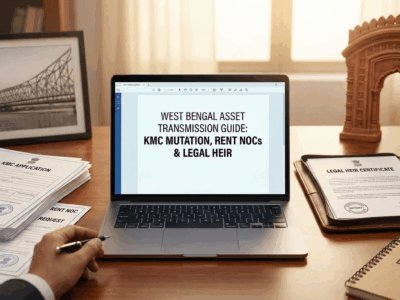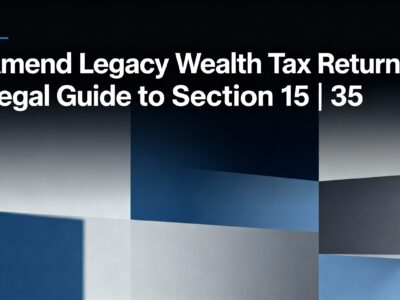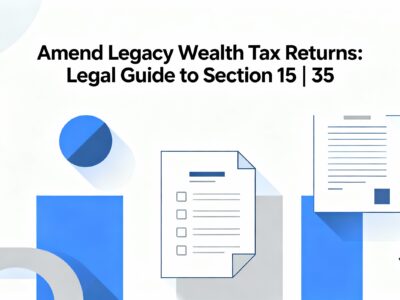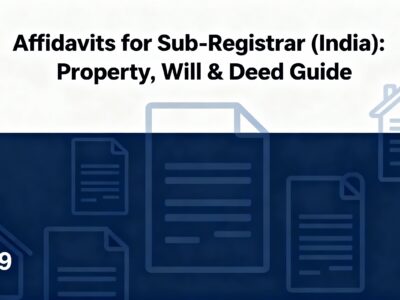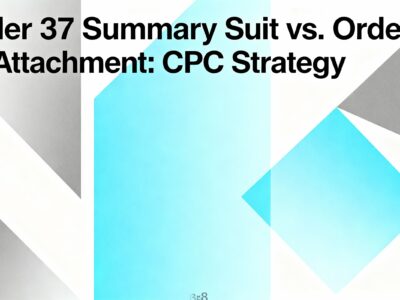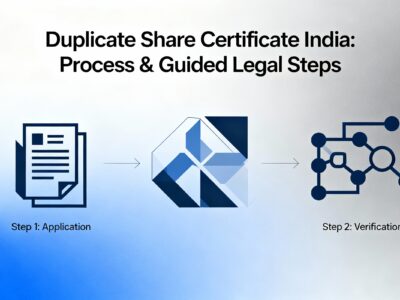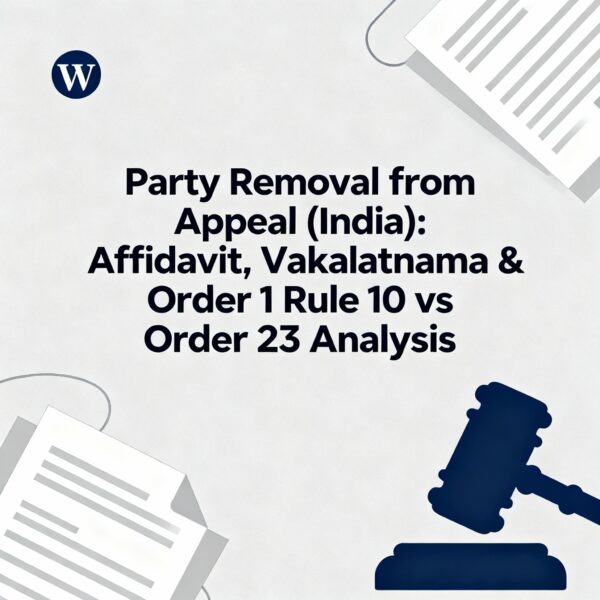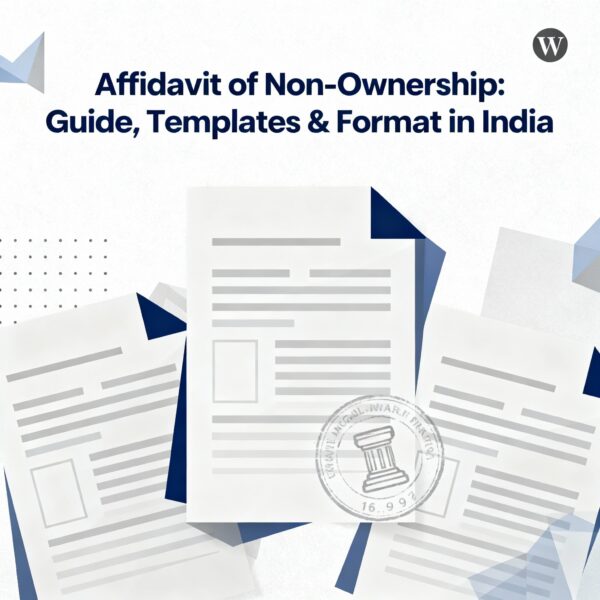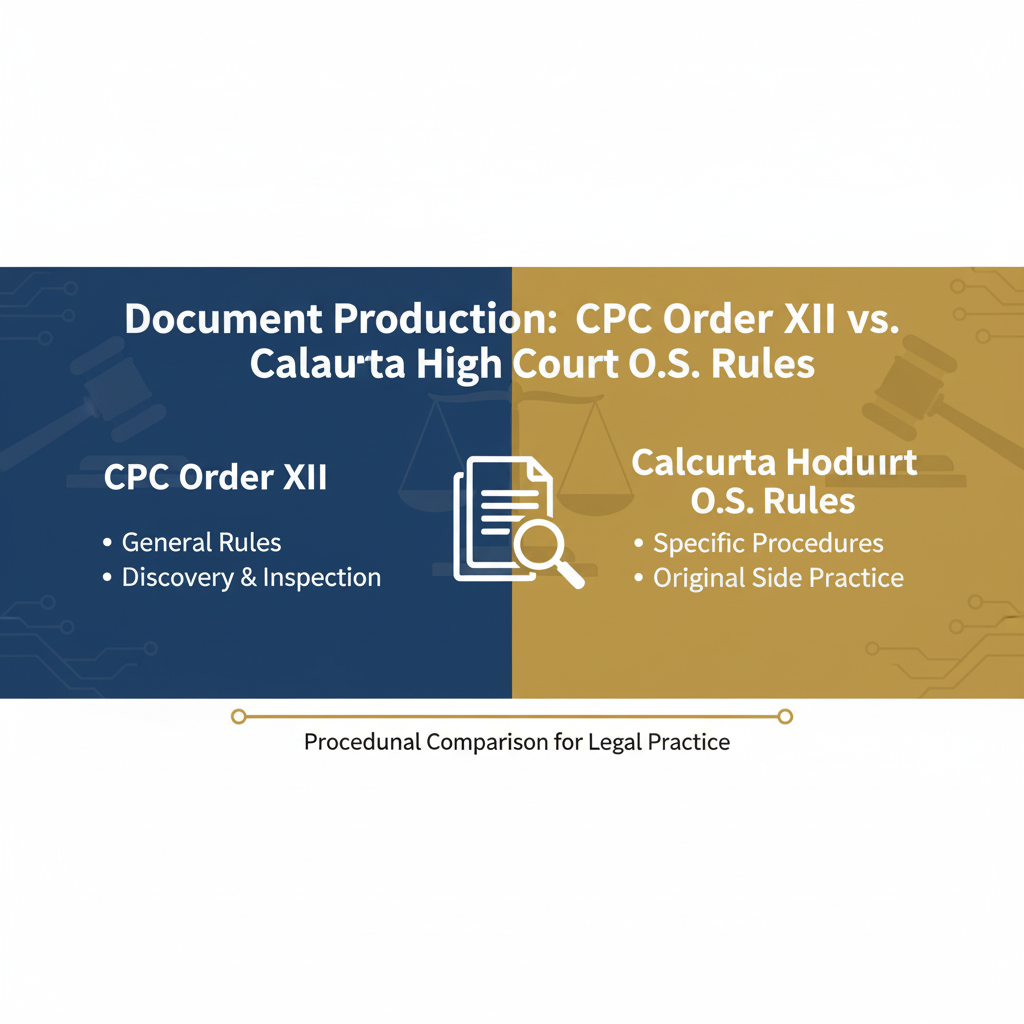Missed the ITR filing deadline and risk losing your tax refund? Or are you a landlord (licensor) struggling to recover rent arrears from a tenant (licensee)? This comprehensive legal guide from Evaakil.com provides a detailed analysis of both issues. We cover the complete process for filing an ITR condonation of delay application under Section 119, including how to prove “genuine hardship.”
We also provide a full procedural guide for recovering licence fee arrears, from the initial legal demand notice to filing a fast-track summary suit under Order 37. Get expert analysis and seven ready-to-use legal draft templates, including affidavits, notices, and court applications, to navigate your tax and property disputes.
Filing Income Tax Returns After the Deadline: A Guide to Condonation Affidavits
Missed the ITR filing deadline? An application for condonation of delay, supported by a strong affidavit, is your formal path to compliance. Updated: October 2025.
Provision: Sec 119(2)(b), Income Tax Act, 1961
What Happens When You Miss the ITR Deadline?
When an assessee fails to file their Income Tax Return (ITR) by the due date (e.g., July 31st) and also misses the "belated return" deadline (December 31st), their right to file that return is extinguished. The online portal closes, and they cannot file, even if they want to.
This creates several problems:
- No Refunds: You cannot claim any tax refunds you are owed.
- Cannot Carry Forward Losses: Business losses or capital losses cannot be carried forward to offset future income.
- Interest & Penalties: You are liable for interest under sections 234A, 234B, and 234C, and penalties under section 234F.
- Notice Risk: It opens the door for a notice from the Income Tax Department, potentially leading to a "Best Judgment Assessment" (Sec 144) where the officer assesses your tax liability for you, often at a higher amount.
The only solution is to file a formal **Application for Condonation of Delay** with the prescribed tax authority (like the Principal Commissioner of Income Tax). The core of this application is an affidavit stating the reasons for the delay.
The Three Paths After Delay
1. Do Nothing
Risk notices, penalties, interest, and potential prosecution. Lose all refunds and loss carry-forwards.
HIGH RISK2. File Belated Return
Possible only until Dec 31st. You pay a late fee (Sec 234F) but can file. Not possible after this date.
TIME-LIMITED3. Condonation (Sec 119)
The only path after Dec 31st. Requires a formal application and affidavit proving "genuine hardship."
OFFICIAL REMEDYWhat is "Genuine Hardship"?
The success of your application depends on proving "genuine hardship." The delay must not be due to mere negligence or carelessness. The reason must be substantial and supported by evidence.
- Strong Reasons (Often Accepted):
- Serious medical emergency of the assessee or a close family member (attach hospital records).
- Death in the family around the due date (attach death certificate).
- Natural disaster (flood, fire) affecting the place of business (attach FIR, photos).
- Loss of records due to theft or data corruption (attach FIR, technical report).
- Wrong advice from a tax consultant (attach consultant's affidavit or letter).
- Weak Reasons (Often Rejected):
- "I was too busy with work."
- "I forgot the deadline."
- "I was out of the country on vacation."
- "My CA was busy."
Interactive Chart: The Cost of Delay
Visualize the mounting interest (Sec 234A) and late fees (Sec 234F). This does not include taxes or other penalties.
Comparison: Genuine Hardship vs. Condonation Affidavit vs. Appeal
| Aspect | Condonation (S. 119) | Appeal (to CIT-A) |
|---|---|---|
| What is it? | A request to the IT Dept to *permit* a late filing. It is an administrative procedure. | A legal challenge *against* an order already passed by the Assessing Officer (e.g., a S. 144 assessment). |
| When to file? | When the deadline to file a belated return (Dec 31) has passed, and you want to file. | After you receive an assessment order, penalty order, or other appealable order. |
| Key Document | Application + **Affidavit** proving "genuine hardship." | **Form 35** + Statement of Facts and Grounds of Appeal. |
| Governing Body | Principal Commissioner or Commissioner of Income Tax (PCIT/CIT). | Commissioner of Income Tax (Appeals), a separate appellate body. |
| Core Argument | "My delay was due to reasons beyond my control." | "The Assessing Officer's order is wrong on facts or in law." |
The Condonation Process: Step-by-Step
Drafting
Prepare the Condonation Application, the ITR-V (as a draft), tax computation, and the Affidavit (Template 1).
Notarization
Get the affidavit sworn and signed before a Notary Public. Attach all supporting evidence (e.g., medical bills).
Submission
Physically submit the complete set to the office of the jurisdictional PCIT/CIT. Get a stamped "Received" copy.
Approval
If approved, the PCIT issues an order. You can then file the ITR online, which the portal will now accept.
Draft Template 1: Affidavit for Condonation of Delay
This is the most critical document. It must be printed on stamp paper (as per state rules, e.g., ₹100) and sworn before a notary.
AFFIDAVIT
I, [Full Name], son of [Father's Name], aged about [Age] years, resident of [Full Address], do hereby solemnly affirm and declare as under:
1. That I am the Deponent herein and a regular assessee of income tax, holding PAN [Your PAN].
2. That I am well-conversant with the facts of this case and competent to swear this affidavit.
3. That for the Assessment Year [AY, e.g., 2023-24], I was required to file my Income Tax Return by the due date of [Due Date, e.g., 31.07.2023] or the belated return deadline of [Belated Date, e.g., 31.12.2023].
4. That I could not file my return within the stipulated period due to genuine hardship.
5. That the reason for the delay is as follows:
[**IMPORTANT: State the reason clearly and chronologically. Be specific.**]
(Example: "That during the period from 15.12.2023 to 15.01.2024, I was hospitalized for an emergency appendicitis surgery at [Hospital Name]. Due to this medical emergency and subsequent recovery period, I was unable to attend to my financial affairs, including the filing of my ITR.")
6. That the delay in filing the return was not intentional, deliberate, or due to any negligence on my part, but solely due to the aforesaid circumstances which were beyond my control.
7. That I have already prepared my Income Tax Return for A.Y. [AY] (a copy of the computation is attached) showing a Total Income of ₹[Amount] and a refund due of ₹[Amount] / tax payable of ₹[Amount].
8. That I am filing an application for condonation of delay under Section 119(2)(b) of the Income Tax Act, 1961.
9. That this affidavit is submitted in support of the said application.
I request that the delay be condoned and I be permitted to file my return.
DEPONENT
VERIFICATION
Verified at [City] on this [Date] day of [Month], [Year], that the contents of the above affidavit are true and correct to the best of my knowledge and belief, and no part of it is false.
DEPONENT
Draft Template 2: Affidavit for Condonation (Lost Refund)
This template is specifically for cases where the primary claim is for a refund that has become time-barred.
AFFIDAVIT
I, [Full Name], son of [Father's Name], aged [Age], resident of [Address], do hereby solemnly affirm and state as under:
1. That I am an assessee holding PAN [Your PAN].
2. That for A.Y. [AY], my total income was ₹[Amount], and the total Tax Deducted at Source (TDS) was ₹[Amount], as reflected in my Form 26AS.
3. That after computing my tax liability, I am entitled to a refund of ₹[Refund Amount].
4. That I was unable to file my ITR for A.Y. [AY] within the due date or the belated return date because [State Genuine Reason, e.g., "I am a senior citizen and was not aware of the change in filing deadlines," or "I was taking care of my ailing spouse, who was bedridden..."]
5. That the failure to claim the refund was due to the aforesaid genuine hardship and was not an attempt to avoid or evade taxes.
6. That my claim is genuine, and I would suffer financial loss if the delay is not condoned and the refund is not processed. (Ref: CBDT Circular No. 9/2015).
7. That this application is being made within six years from the end of the assessment year, as prescribed.
I pray that the delay in filing the return be condoned and the Assessing Officer be directed to process my return and issue the refund due to me.
DEPONENT
VERIFICATION
Verified at [City] on this [Date] day of [Month], [Year], that the contents of the above affidavit are true and correct.
DEPONENT
What If Your Condonation Request is Rejected?
If the Principal Commissioner (PCIT) is not convinced by your "genuine hardship" and rejects your application under Section 119, you cannot appeal this decision to the regular appellate bodies (like the CIT-A or ITAT).
The order passed by the PCIT is an administrative order, not an assessment order. Your only remedy is to challenge this administrative decision by filing a **Writ Petition** before the High Court of your jurisdiction.
Writ Petition (Article 226)
You would file a writ (usually a Writ of Certiorari or Mandamus) under Article 226 of the Constitution of India.
- Grounds for Writ: You cannot just re-argue the facts. You must argue that the PCIT's order is legally flawed.
-
Example Arguments:
- The PCIT did not provide a "speaking order" (an order with reasons).
- The decision was arbitrary or perverse (ignoring clear evidence).
- The PCIT failed to follow the principles of natural justice (e.g., did not give you a chance to be heard).
- The PCIT misapplied the law or the CBDT circulars.
- Outcome: If successful, the High Court will not "allow" your ITR. Instead, it will "quash" (cancel) the PCIT's rejection order and "remand" (send) the case back to the PCIT for fresh consideration.
The Ultimate Consequence: Prosecution under Section 276CC
Beyond late fees and interest, a significant failure to file an ITR can lead to criminal prosecution by the Income Tax Department under Section 276CC. This section criminalizes the **wilful** failure to furnish a return of income.
What is "Wilful" Default?
This is the most important word in the statute. A "wilful" default means the failure to file was intentional, conscious, and deliberate, without a valid or reasonable excuse. It implies *mens rea* (a guilty mind).
- It is not... simple forgetfulness or a mistake. The department must show you *knew* you had to file and *chose* not to.
- It is... a conscious disregard of the legal obligation. For example, ignoring multiple notices from the department could be used as evidence of wilful default.
How Your Condonation Affidavit (Template 1) Becomes Your Defense
This directly connects to our first topic. The affidavit you file for condonation of delay (Template 1) is your primary piece of evidence to prove your failure was **not wilful**.
By swearing an oath and providing evidence of "genuine hardship" (medical emergency, natural disaster, loss of data, etc.), you are creating a formal record that establishes "reasonable cause" for the delay.
If the IT Department were to ever issue a notice for prosecution under S. 276CC, your first line of defense would be to submit the condonation application and the accepted affidavit. This record demonstrates a lack of *mens rea*, as you clearly had a "reasonable cause" and were not acting wilfully.
Key Distinctions: Condonation vs. Revised vs. Defective Return
Assessees often confuse these three distinct provisions. Understanding the difference is essential, as using the wrong one will lead to rejection.
- 1. Condonation of Delay (S. 119(2)(b))
-
Purpose: To ask for permission to file a late return *after* the statutory time limits (including the "belated" return deadline) have expired.
Reason: You must prove "genuine hardship" (e.g., medical emergency, natural disaster).
Document: A formal application and a sworn affidavit (Template 1). - 2. Revised Return (S. 139(5))
-
Purpose: To correct a mistake (like a wrong income figure, a missed deduction, or a wrong bank detail) in a return that was already filed.
Reason: You discovered an "omission or wrong statement" in your original or belated return.
Document: You simply file a new, corrected ITR under the "Revised" filing type. - 3. Defective Return Notice (S. 139(9))
-
Purpose: To fix an incomplete return that the IT Department's system has flagged as "defective."
Reason: The IT Department sends you a notice because you left mandatory fields blank, forgot to attach audit reports, or had incomplete schedules.
Document: You must log in and re-file or correct the return within the 15-day period given in the notice.
Key Takeaway: Condonation is for DELAY. A Revised Return is for MISTAKES. A Defective Notice is for INCOMPLETE filings.
Frequently Asked Questions (ITR Condonation)
Is condonation of delay guaranteed if I have a medical reason?
No, it is not guaranteed. It is at the discretion of the Principal Commissioner (PCIT). Your reason must be "genuine," and you must provide strong evidence. A minor cold will be rejected; emergency hospitalization with records is a strong case. The PCIT will also consider if the delay was truly caused by the medical issue.
What is the time limit for filing a condonation application?
As per CBDT Circular 9/2015, the application must be filed within **six years** from the end of the assessment year in question. For example, for A.Y. 2018-19 (which ended on 31.03.2019), the application must be filed before 31.03.2025.
Can I file for condonation online?
No. This is a common misconception. The application, affidavit, and supporting documents are a physical ("manual") submission to the office of your jurisdictional PCIT/CIT. You cannot do this through the regular e-filing portal.
Will I still have to pay interest and late fees if my delay is condoned?
Yes. Condonation allows you to *file* the return, claim refunds, and carry forward losses. It does **not** automatically waive the late fee (Sec 234F) or interest (Sec 234A/B/C). You must still pay these, although you can file a separate application for a waiver of interest, which is rarely granted.
Final Conclusion (ITR Condonation)
A condonation of delay application is a critical administrative remedy, not a simple formality. The affidavit is the heart of this application. It must be truthful, precise, and strongly supported by evidence.
While a "busy schedule" is not an excuse, the law provides this window for "genuine hardship" cases. The affidavit (Template 1) not only helps in claiming refunds or carrying forward losses but also serves as a crucial piece of evidence to defend against potential prosecution for "wilful" non-filing (S. 276CC).
Disclaimer: The templates and information provided are for educational purposes only. You must consult a qualified Chartered Accountant or Tax Advocate for advice on your specific case.
Acknowledgment of Arrears of Licence Fees in India
A legal analysis of affidavits and acknowledgments used in disputes over licence fee (rent) arrears, and their impact on the Limitation Act.
Provision: Section 18, Limitation Act, 1963
The Problem: Time-Barred Debts
A common issue in property management is the accumulation of licence fee (or rent) arrears. A landlord (Licensor) has a limited time to sue for recovery. Under the Limitation Act, 1963, the limitation period for filing a suit for recovery of rent is **three years** from the date the arrears become due.
For example, if rent for June 2021 was due on July 1, 2021, the licensor must file a suit before July 1, 2024. If they wait, the debt becomes "time-barred," and the court will not entertain the suit.
The Solution: Section 18 of the Limitation Act
Section 18 provides a powerful tool to "reset the clock." It states that if the debtor (Licensee) makes a written **acknowledgment of the debt** before the original three-year period expires, a fresh period of limitation starts from the date of that acknowledgment.
This is why landlords often try to get tenants to sign a letter, affidavit, or even a cheque (which can act as an acknowledgment) for the old dues.
Key Elements of a Valid Acknowledgment (Sec 18)
- Must be in writing. A verbal promise is not enough.
- Must be signed by the debtor (Licensee) or their authorized agent.
- Must be made *before* the limitation period expires. An acknowledgment of a debt that is *already* time-barred does not revive it (that requires a separate promise to pay under Sec 25).
- Must clearly admit liability. It cannot be a letter "denying" the debt but mentioning the amount.
Draft Template 3: Affidavit Acknowledging Arrears (Licensee)
A Licensee might sign this as part of a settlement agreement, perhaps in exchange for not being evicted or to get a waiver of interest.
AFFIDAVIT
I, [Full Name of Licensee], son of [Father's Name], aged [Age], resident of [Address], do hereby solemnly affirm and state as under:
1. That I am the Deponent and am the lawful licensee of the premises at [Full Address of Licensed Premises] ("the said Premises"), under a Licence Agreement dated [Date of Agreement] executed with the Licensor, [Name of Licensor].
2. That I am occupying the said Premises as a licensee.
3. That due to [Reason for delay, e.g., "personal financial difficulties" or "business losses"], I have been unable to pay the licence fees on time.
4. That I hereby admit and acknowledge my liability to pay the outstanding arrears of licence fees for the period from [Start Date] to [End Date], amounting to a total sum of ₹[Total Arrears Amount].
5. That I further acknowledge that this amount is due and payable by me to the said Licensor.
6. That this affidavit is executed by me voluntarily and without any coercion, as an acknowledgment of my outstanding debt.
DEPONENT
VERIFICATION
Verified at [City] on this [Date] day of [Month], [Year], that the contents of the above affidavit are true and correct.
DEPONENT
Licensor's Perspective: Demand Notice for Arrears
Before filing a suit, the first step for any licensor is to send a formal Legal Demand Notice through an advocate. This notice serves several purposes:
- It creates a formal record of the demand.
- It shows the court that you tried to resolve the matter amicably.
- It often intimidates the licensee into paying without a lawsuit.
- The reply from the licensee (if any) becomes a crucial piece of evidence.
Template 4: Legal Demand Notice for Arrears (from Licensor)
[FROM YOUR ADVOCATE'S LETTERHEAD]
Date: [Date]
Regd. Post A.D. / Speed Post
To,
[Full Name of Licensee]
[Address of Licensee]
Subject: Legal Notice for recovery of arrears of licence fees for premises at [Full Address of Premises].
Sir,
Under the instructions and on behalf of my client, [Full Name of Licensor], son of [Father's Name], resident of [Licensor's Address] (hereinafter "my Client"), I do hereby serve you with the following notice:
1. That you are the licensee in occupation of my Client's premises at [Full Address of Premises] ("the said Premises") under a Licence Agreement dated [Date of Agreement].
2. That as per the said agreement, you are liable to pay a monthly licence fee of ₹[Amount] on or before the [Day, e.g., 5th] of each English calendar month.
3. That you have failed and neglected to pay the licence fees since [Start Date] and have fallen into arrears.
4. That as of [Date], a total sum of ₹[Total Arrears Amount] is due and payable by you to my Client, for the period from [Start Date] to [End Date].
5. That my Client has made several verbal requests for payment, but you have failed to clear the outstanding dues.
I, therefore, call upon you through this notice to pay to my Client the said amount of ₹[Total Arrears Amount] within fifteen (15) days from the receipt of this notice.
Should you fail to comply, my Client shall be constrained to initiate appropriate civil and/or criminal proceedings against you for recovery of the said amount, along with interest and costs, entirely at your risk and consequence.
A copy of this notice is retained in my office for further action.
Yours faithfully,
(Advocate's Signature)
[Advocate's Name]
[Enrolment Number]
After the Demand Notice: Filing a Summary Suit (Order 37, CPC)
What happens if you, as the Licensor, send the Demand Notice (Template 4) and the Licensee simply ignores it or refuses to pay? Your next step is to file a civil suit for recovery. However, you may be eligible for a powerful, fast-track option: a **Summary Suit** under Order 37 of the Code of Civil Procedure (CPC).
Why is a "Summary" Suit Better?
A normal civil suit can take many years. A summary suit is designed for clear-cut cases based on written documents, like a Licence Agreement. Its main advantage is speed:
- No Defense by Right: In a normal suit, the defendant (Licensee) can file their defense automatically. In a summary suit, the defendant **cannot** defend the case by right.
- "Leave to Defend": The defendant must first file an application seeking "leave to defend" from the court. They must convince the judge that they have a *real*, *bona fide* defense and aren't just trying to delay the case.
- Immediate Judgment: If the defendant fails to apply for leave, or if their defense is deemed "sham" or "illusory," the court can grant an immediate judgment in your (the Licensor's) favor.
Your Evidence Checklist for a Summary Suit
To succeed, your case must be built on clear, written evidence. The documents we've discussed are the foundation of your suit:
- The Executed Licence Agreement: This is the "written contract" that proves the original liability, the rent amount, and the terms.
- The Demand Notice (Template 4): This proves you made a formal, final demand for payment as required.
- Proof of Service: The Registered Post A.D. or Speed Post receipts showing the notice was delivered (or refused).
- Account Ledger: A clear statement showing the months for which payment is due and the total calculation.
Licensee Strategy: Acknowledging Debt & Requesting Installments
Sometimes the licensee knows the demand for arrears is correct, but they genuinely cannot pay the entire lump sum at once due to cash flow problems. In this situation, fighting the claim (Template 5) is the wrong approach.
A far better strategy is to show good faith. This is done by sending a reply that *admits* the debt (which also resets the limitation period) and proposes a structured payment plan. This often prevents a lawsuit and preserves the business relationship.
Template 6: Reply Acknowledging Debt & Requesting Installments
[FROM YOUR ADVOCATE'S LETTERHEAD]
Date: [Date]
Regd. Post A.D. / Speed Post
To,
[Name of Licensor's Advocate]
[Address of Licensor's Advocate]
Subject: Reply to Legal Notice dated [Date of Notice] & Proposal for Payment
Ref: Your notice on behalf of your client, [Name of Licensor]
Sir/Madam,
Under the instructions and on behalf of my client, [Full Name of Licensee], (hereinafter "my Client"), I am replying to your aforesaid legal notice.
1. That my Client is in receipt of your notice dated [Date of Notice].
2. That my Client admits the outstanding liability of licence fees for the period of [Start Month, Year] to [End Month, Year], amounting to ₹[Total Arrears Amount].
3. That my Client states that due to [Specify reason, e.g., "a severe downturn in business," "an unexpected medical emergency," "a temporary blockage of funds"], my Client faced an acute financial crunch and was unable to pay the licence fees in a timely manner. The default was neither intentional nor deliberate.
4. That my Client has always been a diligent tenant and holds your Client in high regard. To show his *bona fides* and clear all outstanding dues, my Client proposes the following payment plan:
a) An initial payment of ₹[Amount] on or before [Date].
b) The remaining balance of ₹[Amount] to be paid in [Number] equal monthly installments (EMIs) of ₹[Amount] each, starting from [Date of first EMI] and on the [Day, e.g., 5th] of every subsequent month.
c) My Client undertakes to pay the regular monthly licence fees for the current month and future months on time, in addition to the EMI payments.
5. This proposal is made in good faith to resolve the matter amicably. My Client requests yours to accept this proposal and withdraw the legal notice.
Your consideration in this matter would be highly appreciated.
Yours faithfully,
(Advocate's Signature)
[Advocate's Name]
[Enrolment Number]
The Formal Defense: Application for Leave to Defend (Order 37)
If a Summary Suit (Order 37) is filed against the licensee, they cannot simply file a regular defense (a "Written Statement"). They are first required to file this specific application: an **Application for Leave to Defend**.
The entire case hinges on this one document. The licensee must convince the judge that they have a *real*, *arguable*, or "bona fide" defense, not just a "sham" excuse to delay the case.
- Unconditional Leave: Granted if the defense is strong (e.g., proof of payment).
- Conditional Leave: Granted if the defense is arguable but not solid. The judge may order the licensee to deposit the disputed amount in court.
- Leave Rejected: If the defense is deemed baseless, the suit is decreed in the licensor's favor immediately.
Template 7: Application for Leave to Defend (Specimen)
IN THE COURT OF THE [NAME OF COURT, e.g., CIVIL JUDGE, SENIOR DIVISION] AT [CITY]
CIVIL SUIT (SUMMARY) NO. ______ OF 2025
[Name of Licensor] ... Plaintiff
Versus
[Name of Licensee] ... Defendant
APPLICATION FOR LEAVE TO DEFEND UNDER ORDER 37, RULE 3(5) OF THE CODE OF CIVIL PROCEDURE, 1908
The Defendant above-named respectfully submits as under:
1. That the Plaintiff has filed the present Summary Suit for the recovery of an alleged sum of ₹[Amount], which the Defendant received summons for on [Date of Summons].
2. That the present application is being filed within the stipulated period of ten (10) days from the service of summons.
3. That the Defendant has a substantial and *bona fide* defense to the Plaintiff's claim and raises the following triable issues:
[**Ground 1: Payment already made**]
a) That the Plaintiff's claim for arrears is false. The Defendant has paid all dues up to [Month, Year]. The payments for the disputed months were made via [Method, e.g., NEFT/Cheque No. XXX] on [Date]. A copy of the bank statement evidencing this payment is annexed herewith as **Exhibit A**.
[**Ground 2: Counter-claim for breach of contract**]
a) That the Plaintiff has committed a material breach of the Licence Agreement dated [Date]. As per Clause [Clause No.], the Plaintiff was obligated to [Specify obligation, e.g., "provide a functional service lift"].
b) That the Plaintiff failed to provide said service, causing the Defendant business losses of ₹[Amount]. The Defendant is entitled to set-off this amount against any alleged rent due. The reply notice dated [Date] (sent in response to the Plaintiff's demand) is annexed as **Exhibit B**.
[**Ground 3: Document Forged/Inadmissible**]
a) That the suit is based on a document (e.g., "Acknowledgment of Arrears") that was obtained from the Defendant under duress and coercion.
4. That the aforementioned grounds are not sham or illusory and raise several triable issues of fact and law that cannot be decided without a full trial and cross-examination.
PRAYER:
It is therefore most respectfully prayed that this Hon'ble Court be pleased to:
a) Grant the Defendant unconditional leave to defend the present suit;
b) Take this application on record;
c) Pass any such further orders as this Court deems fit.
FILED BY:
(ADVOCATE FOR DEFENDANT)
[Advocate's Name]
[Enrolment No.]
Date: [Date]
Place: [City]
Frequently Asked Questions (Licence Fee)
What is the difference between a "licence" and a "lease"?
A **lease** (governed by the Transfer of Property Act) creates an *interest* in the property for the tenant. A **licence** (governed by the Easements Act) only gives *permission* to use the property for a specific purpose (e.g., "leave and licence" agreements). A licensor generally has an easier time evicting a licensee than a landlord evicting a tenant. However, for rent recovery, the 3-year limitation period is similar.
Does paying part of the arrears reset the limitation period?
Yes. Under Section 19 of the Limitation Act, a part-payment of the principal (or payment of interest) *before* the limitation period expires also starts a fresh period of limitation from the date of payment. The payment must be acknowledged in writing (e.g., a bank statement, cheque, or a signed receipt).
Can I file a criminal case (cheque bounce) *and* a summary suit?
Yes. The remedies are concurrent. If the licensee gave you a cheque for the arrears and it bounced, you can:
1. File a criminal complaint under **Section 138 of the Negotiable Instruments Act** (for the cheque bounce).
2. File a civil **Summary Suit (Order 37)** for recovery of the underlying debt.
Filing one does not stop you from filing the other. The bounced cheque itself is powerful evidence in your Summary Suit.
Final Conclusion (Licence Fee Arrears)
For licensors, time is of the essence. You must be proactive in managing arrears and understand the 3-year limitation period. The strategic use of a Legal Demand Notice (Template 4) followed by a Summary Suit (Order 37) is the most effective recovery path.
For licensees, communication is key. Ignoring a demand notice is the worst possible action. You must respond formally, either by disputing the claim with evidence (Template 5) or by admitting the debt and proposing a payment plan (Template 6). This response will form the basis of your defense (Template 7) if the matter reaches court.
Disclaimer: The templates and information provided are for educational purposes only and are not a substitute for professional legal advice from an advocate.

